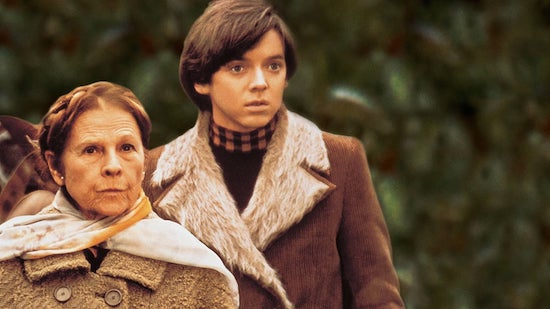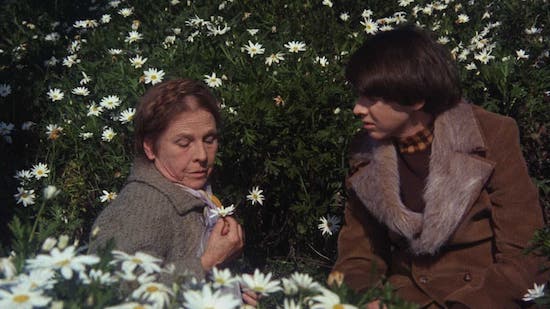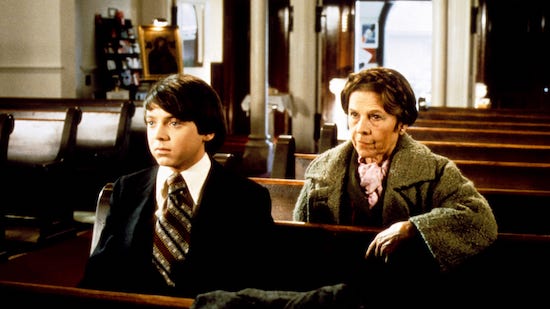A pair of impeccably polished shoes comes down a regal wooden staircase. The camera takes its time, refraining from even introducing us to the figure as his feet savour each and every step, the joyful beat of Cat Stevens’ ‘Don’t Be Shy’ playing in the background. “Don’t wear fear or nobody will know you’re there. Just lift your head, and let your feelings out instead,” Stevens sings with a levity that feels unreachable, just as the man steps onto a stool and kicks it from under his feet.
Just as fast as Harold (Bud Cort) flies into the air, his eyes reopen, wide and alert. His tongue follows, protruding out of his mouth in mockery as his mother enters the room and begins to talk, unbothered by the grisly scene in front of her. This exchange sets the tone for Harold and Maude, Hal Ashby’s 1971 sophomore feature following Harold, a 20-something with a talent for faking suicides, and Maude (Ruth Gordon), a bubbly bundle of energy despite nearing 80.
It is fitting that Harold and Maude arrived in countries including Brazil, Mexico, and Portugal under the title Teach Me How to Live. Even more fitting: the central couple meets at a funeral, starting their lives together as someone bids farewell to theirs, a cyclical allegory that colours Ashby’s ode to life’s poetic patterns. The two share the unusual pastime of attending funerals and burials of people they’ve never met, Harold out of a fascination for the morbid, Maude in an homage to living, death the closing curtains of a spectacular show. Beyond that, they have little in common, but that matters not to the young man, who – until meeting Maude – led a life as stiff as the church benches he spends so much time on.
*
With the exception of maybe Robert Altman, no other filmmaker has so perfectly captured the chaotic essence of the 1970s as Hal Ashby. Between 1970 and 1979, the director rapidly moved from box office failure to coveted Hollywood auteur, delivering an eclectic run that went from timely war critiques like The Last Detail (1973) and Coming Home (1978) to cleverly layered comedies such as The Landlord (1970), Shampoo (1975) and Being There (1979), even dabbling in westerns with 1976’s Bound for Glory.
While laurels are often placed on 1978’s drama Coming Home, Ashby’s heartfelt tale of post-war life, and the Peter Sellers-led 1979 satire Being There, it is Harold and Maude that fully encapsulates the director’s often tender approach when subverting long-established WASP values. When receiving his Oscar for Best Film Editing in 1968 for In The Heat of the Night, Ashby went up on stage and declared: “I only hope that we can use all of our talents and creativity toward peace and love. Thank you.” And this idea of peace and love is sprinkled all over his 1971 unconventional romantic comedy.
“Go and love some more”, says Maude to Harold in one of the film’s most endearing scenes. It is a simple yet heavily charged statement, when considering the time in which Harold and Maude was conceived. Brewed at the end of the ‘60s, at the height of the counterculture movement, Ashby’s creation spoke directly to idealistic values of the hippie decade whilst acknowledging the imminent shift back towards conservatism that America was experiencing at the beginning of the ‘70s, as the New Right gathered to fight their perceived threats against the holy All American morals.

Harold Chasen is the epitome of the tormented young man with a penchant for dark humour (after the aforementioned staged hanging, he smirks when telling his mother he has a “sore throat”). His black hair turns his pale face even paler, his outfits are always overly formal and his overall demeanour is rigid and uncomfortable. He unwillingly lies on a therapist’s couch, and willingly mocks the whole institution of classic psychology. He drives a hearse and when his mother buys him a brand new Jaguar, he picks up a blow-torch and makes yet another hearse – a very expensive one this time around.
In Harold lies the blueprint for characters such as eccentric schoolboy Oliver Tate in Richard Ayoade’s coming of age dramedy Submarine and obsessive-underachiever Max Fischer in Wes Anderson’s early feature Rushmore. In an interview for Parade, Schwartzman fondly remembered being introduced to Harold and Maude as a teenager, saying, “It was the first time that movies made me feel inside the way records did.”
Harold and Maude has done the same for many other young people in the years since its original release, Harold standing for a raging yet contained rebellion that can’t find a home in the anarchic musings of leather-bound rockstars, but doesn’t quite fit in with the peaceful daydreaming of the hippies either. In his perpetual pout lies a thirst for the theatrical (which he quenches through his perfectly executed suicides) and the mixture of genuine torment and a proclivity for drama turns this poor rich boy into a holy grail of sorts, for anxiety-ridden kids in art school dorms all over the world.
Harold prides himself on being detached from societal expectations, whether the simple act of maintaining friendships or the more refined art of finding a suitable partner. He rejoices in his mother’s reprimands, but can’t deny the Freudian motivations behind the gruesome fake self-killings he performs with such gusto. He behaves as if life is nothing but an impediment to death, but clings on to any genuine reason to live. Maude comes in, then, to placate a pain that lay dormant but never quite out of mind, during the years Harold spent at frivolous dinner parties, his mother parading him around without ever showing much interest for the boy.
*
“I had three things that put me about 180 steps ahead of everybody: I was born in this country, I was born white and I was born male. I was way ahead”, Ashby says in Amy Scott’s 2018 documentary Hal while commenting on the racial politics of his directorial debut, The Landlord. And this acute awareness of his privilege made it impossible for the filmmaker to stay put, as the world around him surged with blatant discrimination. In his first film, Ashby explored an interracial relationship in a time where an earnest depiction of one was not often seen onscreen. This white, ungroomed, hippie-looking dude went into the eye of the hurricane by shooting for a brief period of time in a post-white-flight Park Slope, Brooklyn at the end of the ‘60s, a decade marked by the Harlem Riots of 1964 and the assassinations of Malcolm X in 1965 and Martin Luther King Jr. in 1968.
Ashby approached his sophomore feature with a steadier foot when it came to political critique. This is not to say Harold and Maude isn’t as political – on the contrary, here the mere act of living is political. To live a life according to one’s own terms is the ultimate act of rebellion. Harold is drawn to Maude not only because of her careless attitude towards rigid institutions, but also because she simply couldn’t care less. She cares not for outdated laws, social constraints and, above all, she doesn’t care a bit about Harold’s anti-social uneasiness. A woman who has seen the world twice over, Maude has no desire to patrol the way others navigate life, too busy basking in her acceptance of the ephemeral nature of the ride.
Maude is less of a free spirit than she is a spirit freer. She cares deeply about the wellbeing of all living creatures, no matter how small. She steals cars (“Here today, gone tomorrow, so don’t get attached to things”) and unearths trees from posh hotel fronts so they can be returned to the woods where they belong (“The earth is my body, my head is in the stars”, she giddily declares as the sun creeps in between the dense leaves of the enclosure as she returns a plant to soil). She collects all sorts of trinkets, from mismatched utensils to an eclectic array of lamps, and dedicates precious time to concocting useless yet charming inventions. Her abode is rammed up to the ceiling with knick-knacks – but it’s obvious that if it were all to burn to the ground, she wouldn’t bat an eye.
This blend of unadulterated empathy and unfazed detachment allows Maude’s feelings towards Harold to escape the shackles of convention as they lovingly embrace, buoyantly ignoring the weight of preying, judgemental eyes. She sees herself not as a mentor, or the all-knowing entity she was made to stand for. She is a woman and her own woman at that, alert to desires that have not faded with age. In her spare time, she poses nude for a longtime friend to provide him with a much-needed reminder about “the contours of the female form” and merrily applies bright blue eyeshadow over wrinkling eyelids to finish up an outfit on her birthday night. Maude allows herself to feel everything and, in doing so, reclaims the womanhood deemed expired by the ones who express revulsion at the mere idea of her relationship with Harold.

Perhaps the film’s biggest laurel is the lack of time spent dissecting the relationship between Harold and Maude. Ashby guides us through cemeteries and fields as the duo spend their days together in blissful joy, allowing their feelings to bloom amongst the daisies. Harold’s unimpeachable sulkiness dissolves as we bask in the contagious, peaceful melodies of Cat Stevens, who wrote two original songs for the film, ‘Don’t Be Shy’ and ‘If You Want to Sing Out, Sing Out’. The latter, sung by Gordon during one of the film’s most poignant moments, encompasses not only Maude’s epicurean aura but also the libertarian values so tightly held by Ashby. “Well if you want to sing out, sing out, and if you want to be free, be free, ’cause there’s a million things to be. You know that there are,” she happily exclaims, comfortable in the knowledge that she lives by every word.
Harold and Maude’s everlasting appeal is kaleidoscopic, the film equally tender in its approach to ordinary joys as it is in its exploration of existential plights. Its perennial charm, however, comes from the comfort found in a love story that bows to endings with the same grace as it welcomes the excitement of beginnings. Colin Higgins’ script more resembles a sonnet than an elegy in its dance of love and death, and through Ashby’s sensitive eye, tragedy gives place to sensitive contemplation – broken hearts a precious memento of days lived in ecstasy.
50 years on, Ashby’s crown jewel still feels inimitable. Many have tried, and the film’s impact on pop culture is undeniable, from staple noughties dark comedies including Garden State (2004) and Ghost World (2001) to the sharp, nihilistic humour of Netflix absurdist drama The End of the F***ing World. Still, Harold and Maude remains an island, its sublime consciousness of all things living as deeply felt on a hundredth rewatch as it is on a first encounter.
French philosopher Albert Camus once said, “In the end, one needs more courage to live than to kill himself,” while Friedrich Nietzsche stated, “The thought of suicide is a great consolation: by means of it one gets through many a dark night.” Harold and Maude exists somewhere in between the two. It echoes yet another great thinker, Émile Durkheim, in his belief that suicide is, at its core, as human as an act can be. Despite Harold being the one to cling on to the idea of killing himself, it is Maude, ever effervescent, who fully grasps how the awareness of mortality is, after all, what truly enables you to be free, be free.



